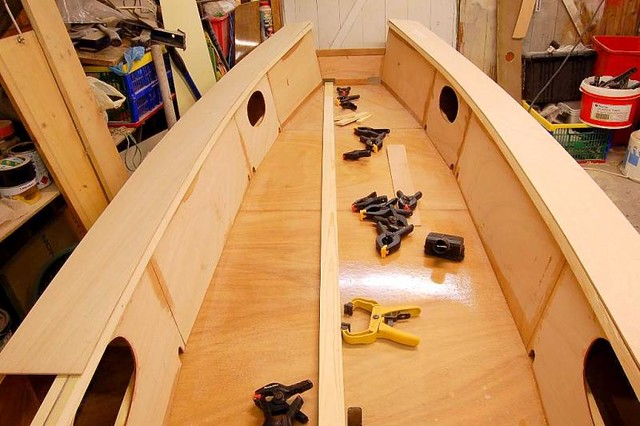More on the trials and tribulations of this design

After the success of the three little 8ft PDRacers in the 200 mile long TEXAS200
This led to a discussion on the Oz Woodwork Forum about a singlehanded boat for long distance events, but be a fair bit faster.
It attempts to leverage the simple construction into a longer and faster package that should be still be reasonably easy for a lone sailor to handle on land or water.
The Raid boat will leverage the construction methods I use to create a relatively simply built distance cruising sailboat for one person with the ability to carry an extra person for more casual sailing.
The stability is scaled to that of the PDRacer which feels very stable on the water and can sail in up to 20+ knots without reducing sail.
The RAID41 uses the same mast and foils as my OZ PDRacer design for anyone interested in upgrading.

The main addition in terms of complexity over the PDRacer is to provide a self draining cockpit. The OZ PDR comes up dry after capsize, but that method was not so feasible in a more curvaceous boat like the RAID.
It is being built by Chris Perkins and Brian Pearson in the wilds of Scotland.
Both Brian and Chris are heavily involved with the homebuilt boating scene in Britain, contributing at times to Watercraft magazine. Their favourite boat show is the wonderful, low key, Beale Park boatshow, where they will be showing the prototype RAID41, ‘Trim’, this year.
Brian sails a Keyhaven Scow, which must be one of the few balance lug rigged racing classes (tech discussion here) left in the world. The sailing level is very serious. John Claridge of International Moth Class design fame is heavily involved in building and rigging the boats.
You can follow the building of the prototype on the pages above.
Lessons from the RAID41
1/ Building effort
The boat took Brian’s friend Chris forever to build. With the internal tankage and raised floor there was too much building time and effort.
Almost like building two boats.
This actually led us to the duct tape assembly method we use on the Quick Canoes, OzRacer RV and as an option for the Oz Goose.
One also requires a little luck with the launchings
We had a couple of disasters.
- Brian in Texas launched his boat late straight into the 200 mile texas200 event after working night and day trying to finish the boat. He was terribly tired. He accidentally connected the water ballast tanks so the two sides filled at once doubling the water capacity. He capsized the boat and while righting it he reached from the centreboard to grab a floating cushion (red) and the boat righted suddenly pushing him underwater with the force of the water ballast. And sailed off. held upright by the water ballast. A few minutes later he was standing as the Texas ICW waterways are channels with wide shallow areas around.
- Brian in the UK was a sailor of great experience. He found a lot of trouble keeping the boat stable on the water even in light winds. He later found out that he had brain tumours in the balance area of the brain. I would have blamed the boat too. He taught us much of what we know about lug rigs.
Here is me sailing the texas boat without tiller extension in Texas. Brian’s boat of course.
Video image can take a moment to load.